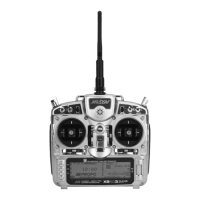1. To assign a 2nd channel to Ailerons, Elevator, Rudder
or Flaps, highlight and select INH under the desired
channel on the Mate line of the Wing TYPE display
and a list of available channels is displayed.
Note: Channels/Switches must be inhibited (INH) in
the Devic. SEL function before they appear in the
list as an option to be used as a Dual channel.
1. If the aircraft has a V-tail configuration, highlight INH
next to V-tail in the Wing TYPE function and press the
Selector until ACT appears. Plug the right Elevator
servo into the Elevator channel (Ch3) and plug the left
Elevator servo into the Rudder channel (Ch4). Pressing
the Selector toggles the parameter between ACT and
INH. If the aircraft has a normal tail, make sure INH
is selected and plug the Elevator and Rudder servos
into the Elevator and Rudder channels (Ch3 and Ch4
respectively). Continue with Dual Channels below.
2. Highlight and select the channel that is to be the Mate
(slave) to the control channel represented above it.
Plug the 2nd control surface servo into the channel
selected as the Mate.
3. If FLAP or AUX3 is selected as a Mate, INH
will appear on the Trim Line of the display directly
beneath the channel just selected. This means that
the corresponding digital switch (FLAP TRIM or
AUX TRIM) located next to the FLAP and AUX2
switches can be used as additional trim. However,
the additional trims do not function in the
same fashion as regular trims. Instead, they
trim the controls such that both channels move in the
same direction – like reflexing both Ailerons or in
the case of Elevator halves, the Elevators would move
in opposite directions. As a result, you should
leave these additional trims inhibited unless
you’ve a special need for them. If changed to
ACT, the corresponding trim switch (FLAP or AUX3)
will become active. If set to INH these additional trim
switches are inactive. Normal trims continue to work
regardless of the settings.
Note: To properly set the servo direction when
using the V-tail setting, begin by using servo
reversing on each channel as necessary to get the
elevators to move the proper direction with rudder
stick movement. If the elevators move the incorrect
direction with elevator stick movement, swap the
channels that the servos are plugged into in the
receiver to reverse them.

